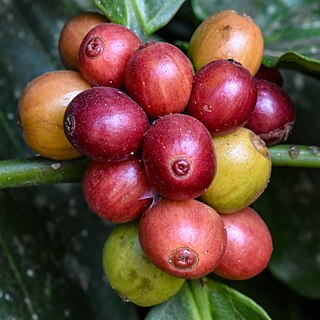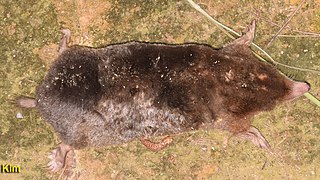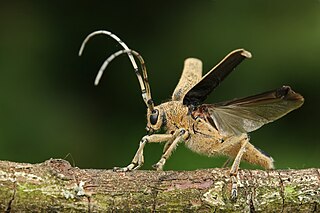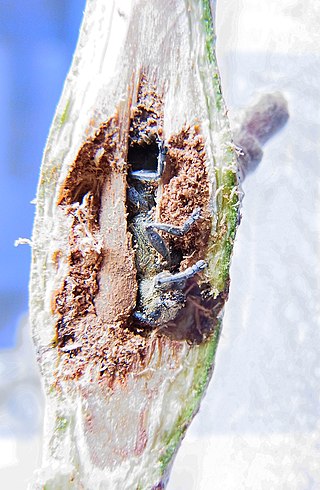
Coffea canephora is a species of coffee plant that has its origins in central and western sub-Saharan Africa. It is a species of flowering plant in the family Rubiaceae. Though widely known as Coffea robusta, the plant is scientifically identified as Coffea canephora, which has two main varieties, robusta and nganda.

Washingtonia robusta, known by common name as the Mexican fan palm, Mexican washingtonia, or skyduster is a palm tree native to the Baja California peninsula and a small part of Sonora in northwestern Mexico. Despite its limited native distribution, W. robusta one of the most widely cultivated subtropical palms in the world. It is naturalized in Florida, California, Nevada, Arizona, New Mexico, Hawaii, Texas, parts of the Canary Islands, Spain, Portugal, France, Italy, Malta, Albania, Greece, Turkey, Cyprus, Israel, Palestine, Jordan, Lebanon, Syria, Iraq, Saudi Arabia, Somalia, Bahrain, Qatar, United Arab Emirates, Oman, Yemen, Iran, Afghanistan, Egypt, Libya, Tunisia, Algeria, Morocco, and Réunion,.

Grevillea robusta, commonly known as the southern silky oak, silk oak or silky oak, silver oak or Australian silver oak, is a flowering plant in the family Proteaceae, and accordingly unrelated to true oaks, family Fagaceae. Grevillea robusta is a tree, and is the largest species in its genus. It is a native of eastern coastal Australia, growing in riverine, subtropical and dry rainforest environments.

The Ussuri mole or large mole, is a species of mammal in the family Talpidae, formerly treated as a subspecies of the Japanese mole. It is found in China, North Korea, South Korea, and Russia and lives in a long burrow, seldom emerging on the surface of the ground during the day.

Saperda carcharias is a species of longhorn beetle.

Saperda is a genus of flat-faced longhorn beetles belonging to the family Cerambycidae, subfamily Lamiinae. The genus was erected by Johan Christian Fabricius in 1775.

Saperdini is a tribe of longhorn beetles of the subfamily Lamiinae.

Saperda calcarata, the poplar borer, is a species of beetle in the family Cerambycidae. It was described by Thomas Say in 1824. It is known from Canada and the United States. It contains the varietas Saperda calcarata var. adspersa.
Saperda inornata is a species of beetle in the family Cerambycidae. It was described by Thomas Say in 1824. It is known from Canada and the United States. It feeds on Populus tremuloides.

The Linden borer is a species of beetle in the family Cerambycidae. It was described by Thomas Say in 1824. It is known from Canada and the United States. It feeds on Tilia americana.

Saperda candida, the roundheaded appletree borer, is a species of beetle in the family Cerambycidae. It was described by Johan Christian Fabricius in 1787. It is known from Canada and the United States. It contains the varietas Saperda candida var. bipunctata.
Saperda horni is a species of beetle in the family Cerambycidae. It was described by Joutel in 1902. It is known from Canada and the United States. The species name is often misspelled as hornii.
Saperda interrupta is a species of beetle in the family Cerambycidae. It was described by Gebler in 1825. It is known from China, Russia, Siberia, Korea and Japan. It is associated with coniferous plantations, and infests species of fir, pine, spruce and other conifers.
Saperda lateralis is a species of beetle in the family Cerambycidae. It was described by Johan Christian Fabricius in 1775. It is known from Canada and the United States.

Saperda perforata is a species of beetle in the family Cerambycidae. It was described by Pallas in 1773, originally under the genus Cerambyx. It has a wide distribution in Europe. It feeds on Populus nigra, Populus alba, and Populus tremula. It is preyed upon by the parasitoid wasp Xorides indicatorius.

Saperda populnea, the small poplar borer, is a species of beetle in the family Cerambycidae which forms woody galls on twigs of poplars and willows. It was described by Carl Linnaeus in 1758.

Saperda quercus is a species of beetle in the family Cerambycidae. It was described by Charpentier in 1825. It is known from Turkey, Romania, Bosnia and Herzegovina, Jordan, Serbia, Bulgaria, Greece, Syria, and possibly Hungary. It feeds on Quercus coccifera.

Saperda scalaris is a species of beetle in the family Cerambycidae. It was described by Carl Linnaeus in 1758, originally under the genus Cerambyx. It has a wide distribution in Europe and Asia. It is preyed upon by parasitoid wasp species including Xorides praecatorius and Helcon angustator.

The elm borer is a species of beetle in the family Cerambycidae. It was described by Guillaume-Antoine Olivier in 1795. It is known from Canada and the United States. It feeds on Ulmus rubra and Ulmus americana. It acts as a vector for the fungus Ophiostoma ulmi, and as a host for the parasitoid wasp Cenocoelius saperdae.
Kahawa Sūg, also known as Sulu coffee or Sulu robusta, is a single-origin coffee varietal grown by the Tausug people of the Sulu Archipelago, Philippines. It is a robusta cultivar, belonging to the species Coffea canephora. It originates from robusta plants introduced to Sulu in the 1860s. It is an important part of traditional Tausug culture. It is mostly consumed locally, though it has started being exported more widely in recent years. It is currently endangered by the introduction of modern higher yield coffee varieties.














